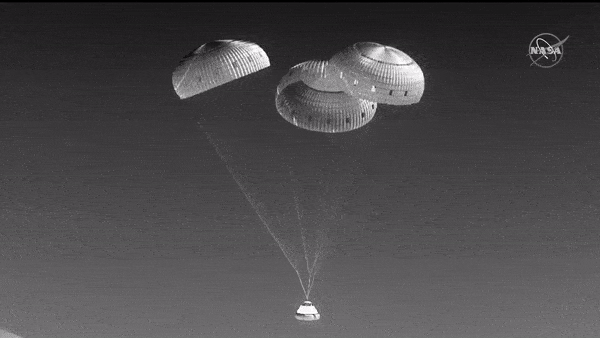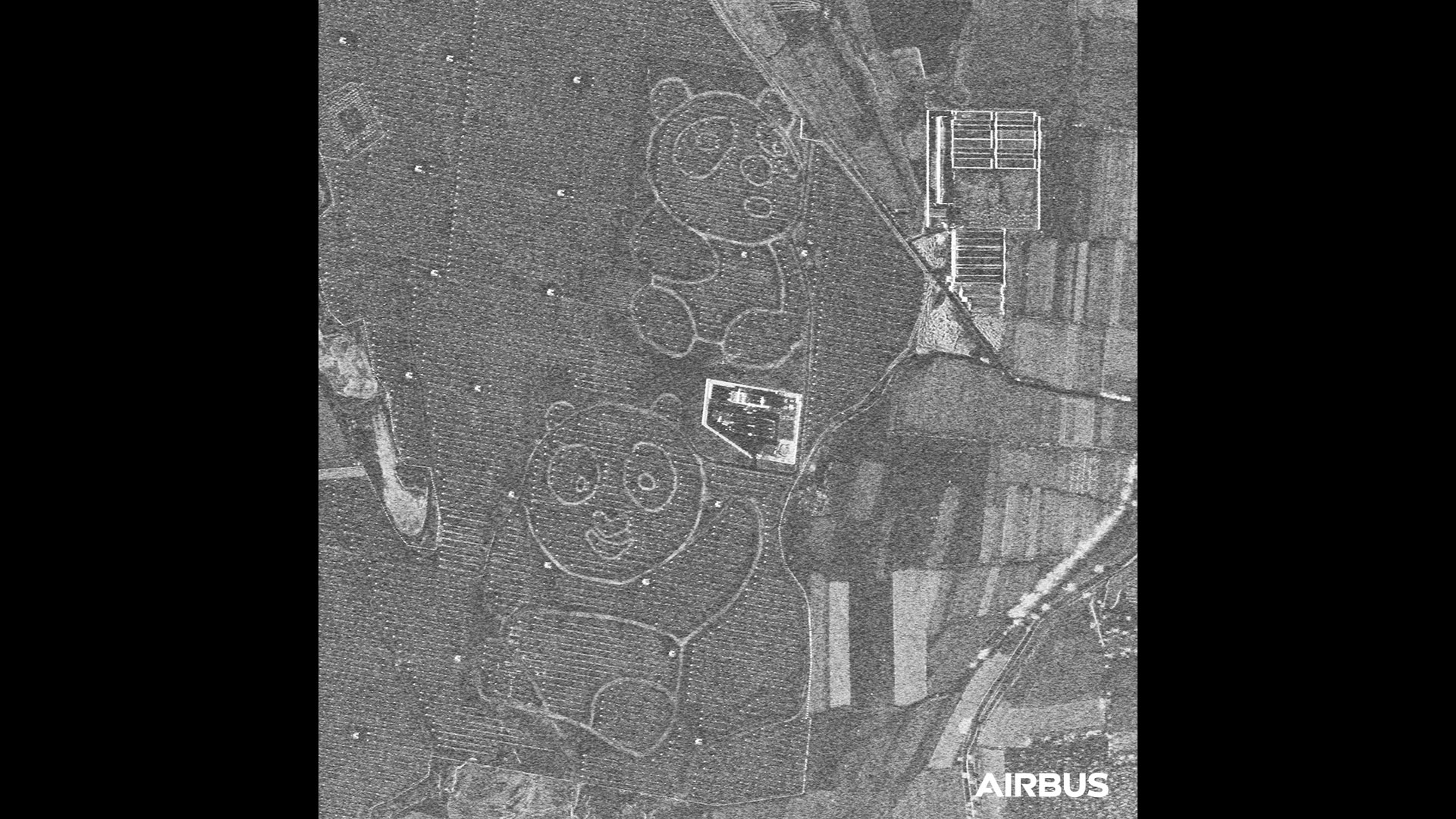May 2022
A bright shooting star shines above Red Planet-like rock

Tuesday, May 31, 2022: This image of a tau Herculids meteor looks like it belongs on Mars, but it actually was taken from a ruddy area of Nevada. The shooting star was captured May 30 from the Valley of Fire State Park as Earth ran into numerous shards from comet 73P/Schwassmann-Wachmann, or SW3. There was no storm of shooting stars as some had hoped, but many meteor watchers around the world caught bright streakers like this one. — Elizabeth Howell
Stunning South Pole lunar eclipse on the aurora backdrop

Friday, May 27, 2022: This stunning time-lapse photograph shows the May 15 total lunar eclipse above an astronomical observatory at the South Pole on the backdrop of magnificent auroras and the star-studded polar sky.
The picture was taken by Aman Chokshi, a PhD astronomy student at the University of Melbourne, Australia, who is currently spending a year working at the South Pole Telescope in Antarctica, which studies microwave radiation emitted by the cosmos as part of the black-hole watching Event Horizon Telescope network.
"Last Monday we were lucky to see a total lunar eclipse from the South Pole," Chokshi told Space.com in an email. "The moon gradually dimmed and turned orange. It was crazy to see how the sky dimmed and the millions of stars of our Milky Way galaxy emerged. At the peak of the eclipse, a band of glowing auroras surged across the sky. A truly spectacular evening!"
Chokshi (whom you can see in the picture together with a friend waving into the camera from the edge of the roof of the telescope building), took the images that make up this time lapse over a 5-hour period.
"The background image is a single 20-second exposure with a sigma 24-70 millimeter lens, at f/2.8, iso 3200 on a Sony A7RVI, captured at the peak of the eclipse," Chokshi said. "The array of moon images were captured with an old sigma 400mm film lens, on a Sony A7S, on a skywatcher star adventurer tracker. The final composite image contains images of the moon every four minutes."
It took some courage and resourcefulness for Chokshi to take the images. The South Pole, currently nearing the peak of the winter period, is submerged in permanent darkness, and the polar expeditioners have to put up with some of the most extreme weather conditions one can experience on Earth.
Get the Space.com Newsletter
Breaking space news, the latest updates on rocket launches, skywatching events and more!
"We had a sustained wind of 15-20 knots, which brought the ambient temperature of minus 60 degrees Celsius [minus 76 degrees Fahrenheit] to minus 80 degrees C [minus 112 degrees F] with windchill," Chokshi said. "Both cameras had to be housed in special heated foam boxes which I made, to prevent them from freezing."
For more stunning South Pole and astronomy photography, follow Chokshi on Instagram @aman_chokshi
-- Tereza Pultarova
Starliner lands safely, concluding a successful delayed test flight

Thursday, May 26, 2022: Boeing's Starliner space capsule has safely touched down at a missile range in New Mexico, concluding a successful, although more than a year delayed, test flight.
Starliner, which is set to join SpaceX's Crew Dragon in ferrying astronauts to and from the International Space Station, spent five days docked at the orbital outpost running through a series of tests.
The capsule launched on May 19 atop United Launch Alliance's Atlas V Rocket from Cape Canaveral in Florida. The test flight was Boeing's second uncrewed attempt to demonstrate the performance of the technology, after its first orbital test flight failed to reach the space station in December 2019 due to software glitches. The capsule may perform its first flight with astronauts by the end of this year. – Tereza Pultarova
The last rays of the setting sun seen from International Space Station

Wednesday, May 25, 2022: Astronauts aboard the International Space Station took this stunning image of the sun setting above south-African Botswana on May 7.
The image captures the very last rays illuminating Earth's horizon seen from the space station's vantage point at 263 miles (432 kilometers) above the planet.
Astronauts at the space station get to enjoy stunning views on a regular basis including mesmerizing auroras displays and lunar eclipses. You can explore NASA Johnson Space Center's Flickr stream for more 'out of this world' photography. – Tereza Pultarova
InSight Mars lander's death by dust

Tuesday, May 24, 2022: NASA's InSight Mars lander is slowly losing its battle against the dust, which has accumulated on its solar panels, preventing the spacecraft from generating the energy it needs to continue science operations.
This animation compares the state of InSight's solar panels in December 2018, shortly after its arrival to the red planet, and on April 24, 2022, after 1,211th Martian days. In a Twitter post, NASA described the second image as InSight's "final selfie".
Because of the dust cover, it has been increasingly difficult to keep InSight going and it is likely that NASA will kill the mission completely in the very near future.
The robotic arm, which was used to take those images, is expected to be put into a "retirement position" by the end of May, NASA said in a statement, because the solar panels no longer produce enough electricity to make it move. – Tereza Pultarova
Boeing's Starliner spaceship docked at International Space Station

Monday, May 23, 2022: After years of delays and one failed attempt, Boeing's Starliner space taxi has finally reached the International Space Station during its second unmanned orbital test flight.
The capsule, which will share the task of ferrying astronauts to and from the orbital outpost with SpaceX's Crew Dragon, docked at the station on Friday night (May 20) after a 26-hour spaceflight.
This picture was taken by European astronaut Samantha Cristoforetti shortly after the docking. Later, NASA astronaut and Cristoforetti's crew mate Kjell Lindgren commented on the picture on Twitter: "It's been a busy and amazing 3 weeks. So excited to be back in orbit with Exp67 and to welcome Boeing #Starliner to the International Space Station."
Starliner is expected to remain at the International Space Station until the middle of this week. It will perform a series of orbital tests before returning to Earth when weather permits. – Tereza Pultarova
Boeing's Starliner on its way to International Space Station

Friday, May 20, 2022: Boeing's Starliner capsule finally lifted off for its second test flight to the International Space Station after many months of delays.
The capsule, designed to carry astronauts to the orbital outpost, launched atop a United Launch Alliance Atlas V rocket from Cape Canaveral Space Force Station in Florida at 6:54 p.m. EDT (2254 GMT) on Thursday (May 19).
The flight, the Orbital Flight Test 2 (OFT-2), is Boeing's second uncrewed demonstration after Orbital Flight Test 1, which failed to reach the space station in December 2019.
The mission was originally scheduled for last summer but was postponed due to issues with the capsule's propulsion system. – Tereza Pultarova
Astronaut's spine after six months in space

Thursday, May 19, 2022: NASA astronaut Raja Chari shared this image of his spine as he is recovering after six months on the International Space Station.
Chari, who was a member of the Crew-3 mission, which returned to Earth on May 5 on board of SpaceX's Crew Dragon capsule, shared the image on Twitter together with other images of him being subject to various tests in order to evaluate the state of this body after his orbital mission.
"Science continues after @NASA_Astronauts return from @Space_Station," he said. "For months #Crew3 will gather data for human research experiments to compare to in-flight. Our brain & vestibular system are nearly back to normal, but it’ll take months to get muscles & bones back to normal."
In the absence of gravity, astronauts' muscles and bones weaken in spite of the rigorous exercise regime that the spacefarers follow. This physical deterioration is one of the biggest obstacles for long-term human presence in space. Studies by NASA suggest that it may take more than a year for the bones to regain their former strength. – Tereza Pultarova
Sun's poles photographed in greatest detail ever

Wednesday, May 18, 2022: The European Solar Orbiter spacecraft captured the closest ever images of the sun's south pole, an area responsible for the generation of the star's magnetic field.
The image was taken during Solar Orbiter's closest pass at the sun on March 26. At that point, the spacecraft, fitted with ten scientific instruments, approached the star at the center of our solar system as close as one third of the sun-Earth distance.
Studying the sun's poles is one of the main tasks of Solar Orbiter. Polar regions are believed to play a key role in the generation of the sun's magnetic field, which drives its 11-year-long cycle of activity, the periodic ebb and flow in the generation of sunspots, solar flares and eruptions. – Tereza Pultarova
Saharan dust storm heading to America

Tuesday, May 17, 2022: A massive cloud of dust swept up by winds over the Saharan desert has been photographed by European satellites as it moves over the Atlantic Ocean towards the Caribbean.
The image, taken on May 15 by the Sentinel-3 spacecraft, shows the dust cloud drifting westward from the coast of Senegal and Gambia. The European Copernicus environment monitoring service predicts the cloud will reach the Caribbean within a few days.
This is not the only dust event going on around Africa these days. Massive dust storms have been observed also on the Arabian Peninsula. – Tereza Pultarova
Eclipsed moon above a SpaceX Falcon Heavy monument in California

Monday, May 16, 2022: The fully eclipsed moon photographed above a monument of SpaceX' Falcon Heavy rocket in Hawthorne, California, during the Flower Moon eclipse on May 15.
The Flower Moon eclipse was the first of 2022 and was best observed from the Americas. Skywatchers in Western Africa and Europe also got to see parts of it. The eclipse, the longest total lunar eclipse in 33 years, started at 10:28 p.m. EDT on Sunday May 15 (0228 GMT on May 16) and reached its peak May 16 at 12:11 a.m. EDT (0411 GMT). The moon spent 85 minutes inside the Earth's full shadow, the umbra. – Tereza Pultarova
Years-long imaging campaign reveals Milky Way's central black hole

Friday, May 13, 2022: The supermassive black hole at the center of our galaxy, the Milky Way, can be seen in this image taken by the Event Horizon Telescope as part of a ground-breaking campaign.
Scientists have known for decades that there is a strange source of radio waves, known as Sagittarius A*, at the center of our galaxy. Over the years, more and more evidence has been gathered that this source must be a supermassive black hole. Any residual doubt has now been removed when the worldwide Event Horizon Telescope partnership succeeded to take the first ever photograph of this strange source, revealing a characteristic shadowy center surrounded by a glowing disk of material falling into the black hole.
The image of Sagittarius A* is only the second image of a black hole ever taken, the first being that of the much larger black hole at the center of the galaxy M87, which was released in 2019. – Tereza Pultarova
Satellite spots panda-shaped power plant in China

Thursday, May 12, 2022: A radar Earth-observing satellite of European aerospace firm Airbus recently captured this image of the Datong Panda Power Plant in China.
The plant, in China's northern Shanxi province, covers 0.4 square miles (1 square kilometer) and generates 50 Megawatt of solar power, about the annual consumption of 3,600 four-person households. The plant was built in 2017 with support of the United Nations Development Program. – Tereza Pultarova
First made-in-Europe micro launcher unveiled

Wednesday, May 11, 2022: A British rocket company Orbex has unveiled a prototype of its reusable micro-rocket Prime as it prepares for its debut flight later this year.
Prime is the first of Europe's micro launcher developments to achieve this stage. Designed to take into orbit satellites of up to 440 lbs (200 kilograms), the rocket uses renewable fuel biopropane, which slashes the carbon footprint of each launch by over 90% compared to equivalent rockets relying on fossil fuels.
Orbex will launch its rockets from Space Hub Sutherland, a new spaceport in the north of Scotland. It plans to fly Prime for the first time by early 2023 in what it hopes will be the first vertical launch from U.K. soil. However, other companies are working on their rockets as well and have plans to launch soon. – Tereza Pultarova
Matthias Maurer getting into shape after return to Earth

Tuesday, May 10, 2022: European Space Agency's (ESA) astronaut Matthias Maurer is working out at a gym at Europe's astronaut center in Germany to regain muscle mass after his return to Earth from the International Space Station.
"Back in the gym – the weights all seem heavier than I remember 😆," Maurer said in a tweet. "This rehabilitation helps restore my muscles & bones after 177 days in microgravity & engages muscles we need on Earth but don't use so much in space."
Maurer splashed down off the coast of Florida together with his Crew-3 team mates NASA astronauts Raja Chari, Thomas Marshburn and Kayla Barron on Friday, May 6. – Tereza Pultarova
Partial solar eclipse above Chile's Atacama Desert

Monday, May 9, 2022: A partial solar eclipse above the Atacama Desert in Chile provided a fascinating spectacle to sky-watchers at the popular astronomy destination.
This photograph was taken by the European Southern Observatory (ESO) photographer Pavel Horálek on April 30 near San Pedro de Atacama above the Moon Valley, a popular tourist spot featuring lunar-like landscapes.
The photo shows a sequence of images capturing the progress of a partial solar eclipse, caused by the moon obscuring a fraction of the sun's disk. The sequence was taken over a period of 54 minutes just as the sun was about to set, ESO said in a statement.
The dusty glow of the image is caused by volcanic ash from the Hunga Tonga volcano, which erupted in January this year in the Southern Pacific Ocean. The ash, ESO said in the statement, remains suspended in the atmosphere nearly four months after the eruption. – Tereza Pultarova
Crew-4 Dragon capsule splashes down off Florida coast

Friday, May 6, 2022: SpaceX Dragon Endurance capsule carrying Crew-4 astronauts from the International Space Station splashed down off the coast of Florida at 12:43 a.m. EDT (0443 GMT) on Friday, May 6.
NASA astronauts Raja Chari, Thomas Marshburn and Kayla Barron were on board of the capsule together with European astronaut Matthias Maurer. The quartet returned to Earth after almost six months in orbit. – Tereza Pultarova
Tornado lighting flashes seen from space

Thursday, May 4, 2022: Thunderstorms that produced devastating tornadoes across Oklahoma and Texas on Wednesday (May 4) provided a spectacular lighting display that was captured by weather satellites monitoring the planet.
This video sequence was taken by the GOES East satellite, operated by the National Oceanic and Atmospheric Administration (NOAA), from its vantage points over 22,000 miles (36 kilometers) above Earth.
On the ground, severe hail storms with hail larger than golf balls were reported in some areas, together with wide-scale power outages and damage to infrastructure caused by strong winds. – Tereza Pultarova
Boeing's Starliner capsule meets rocket ahead of ISS test launch

Wednesday, May 4, 2022: Boeing's Starliner space capsule has been transported into the United Launch Alliance Vertical Integration Facility at NASA's Kennedy Space Center, where it will be placed atop an Atlas V rocket ahead of a test flight to the International Space Station on May 19.
The heavily delayed test flight will be Boeing's second attempt to reach the space station. The capsule previously failed to reach the orbital outpost in December 2019.
If successful, the Orbital Flight Test-2 will clear the way for Boeing to join SpaceX in ferrying astronauts to and from the International Space Station for NASA. – Tereza Pultarova
Helicopter catches Rocket Lab's Electron booster in first step toward reusability

Tuesday, May 3, 2022: Rocket Lab has managed to retrieve the first stage of its Electron rocket using a helicopter in a milestone step toward reusability.
The rocket lifted off from Rocket Lab's New Zealand site with 34 satellites aboard at 6:49 p.m. EDT (2249 GMT) on on Monday (May 2). Its first stage returned to Earth some 15 minutes later, gliding down on a parachute, and was caught by a Sikorsky S-92 helicopter using a hook. The chopper later hauled the booster to a recovery ship, which will transport the hardware back to terra firma for inspection and analysis. – Tereza Pultarova
Shiny! Crew Dragon Endeavour readies for undocking

Monday, May 2, 2022: Crew-3's ride home is undergoing final checkouts ahead of an expected landing no earlier than Thursday (May 5), weather depending. Matthias Maurer, an astronaut from the European Space Agency, took this snapshot amid final checkouts for the SpaceX Crew Dragon Endurance. "Soon it's time to head back to Earth & I'm looking forward to home, but also getting a bit wistful that it'll soon be time to say goodbye," Maurer tweeted Sunday (May 1). — Elizabeth Howell
Can't find the date you're looking for? It may have been a weekend or holiday, when we don't normally update our Image of the Day.
Click 'NEXT PAGE' below for Jun >
Join our Space Forums to keep talking space on the latest missions, night sky and more! And if you have a news tip, correction or comment, let us know at: community@space.com.

Space.com is the premier source of space exploration, innovation and astronomy news, chronicling (and celebrating) humanity's ongoing expansion across the final frontier. Originally founded in 1999, Space.com is, and always has been, the passion of writers and editors who are space fans and also trained journalists. Our current news team consists of Editor-in-Chief Tariq Malik; Editor Hanneke Weitering, Senior Space Writer Mike Wall; Senior Writer Meghan Bartels; Senior Writer Chelsea Gohd, Senior Writer Tereza Pultarova and Staff Writer Alexander Cox, focusing on e-commerce. Senior Producer Steve Spaleta oversees our space videos, with Diana Whitcroft as our Social Media Editor.
